· home clean energy credit · 4 min read
What's the Home Clean Energy Credit?
The Residential Clean Energy Credit is more than just a tax incentive; it's a catalyst for change in the way we approach energy in our homes.

As we navigate towards a sustainable future, two key terms often surface: “clean energy” and “energy efficiency.” While they may seem synonymous, they represent distinct facets of our energy landscape. Clean energy taps into natural forces like the sun, wind, and Earth’s core, while energy efficiency optimizes consumption. Though both concepts are equally important, much like making and saving money in business, the focus of the Residential Clean Energy Credit Act is solely on creating energy. In this article, we’ll explore the ways we can harness these natural forces to fuel our sustainable future.
What is the Residential Clean Energy Credit?
The Residential Clean Energy Credit tax code (25D) is a significant step towards encouraging clean energy adoption in residential settings. This Act provides a 30% tax credit with no upper limit and a rollover option if you don’t have the appropriate tax liability to claim it in one year. It primarily targets six types of clean energy technologies: solar energy systems, geothermal heat pumps, residential wind turbines, solar water heaters, battery storage technologies, and solar storage solutions.. You can verify the details of the Residential Clean Energy Credit Act here on the IRS website.
Solar Energy Systems
Solar energy systems are a smart choice for homeowners looking to tap into clean energy. These systems convert sunlight into electricity, offering a dependable power source that can lead to significant energy independence. Solar panels, typically mounted on rooftops, absorb sunlight and transform it into usable electricity for your home.
For those just starting out, our Solar Basics page covers the fundamentals, helping you decide if solar is right for your home.
If you’re focused on the financial aspects, such as understanding loans and incentives for the best investment return, our Solar Tax Incentive page provides detailed insights into the economics of solar energy.
Geothermal Heat Pumps
Geothermal heat pumps tap into the consistent warmth of the earth’s subsurface to provide efficient home heating and cooling. This alternative to traditional HVAC systems is slowly gaining popularity due to its minimal environmental impact and substantial energy savings potential. The Inflation Reduction Act’s uncapped credit, coupled with the system’s potential to last up to 50 years, positions geothermal energy as a smart, long-term investment. As the technology advances, we can expect a broader adoption of geothermal solutions, contributing significantly to the stability of the power grid. For an in-depth exploration, visit our [geothermal heat pumps] page.(geothermal-heat-pumps-tapping-into-the-earths-core).
Residential Wind Turbines
Residential wind turbines are carving out a niche in the clean energy landscape, offering a complementary power source to traditional grid energy. These turbines convert wind into usable electricity, ensuring energy flow during times when solar energy may be scarce, such as during overcast conditions or at night. The synergy between wind and solar energy is particularly beneficial, as wind turbines tend to produce more power during seasons when solar output is lower, thus bridging the gap in household energy needs. Technological strides and tax incentives from the Act are making residential wind turbines a practical choice for homeowners. Learn more on our Residential Wind Turbines page.
Solar Water Heaters
Solar water heaters are a smart choice for homeowners looking to cut energy costs and boost their emergency preparedness. By harnessing the sun’s power, these systems can slash your water heating bills by 50-80%, offering substantial savings. They’re a reliable ally in emergencies, providing hot water without draining your home’s energy storage, leaving more power for essentials like heating and cooling. With the Inflation Reduction Act sweetening the deal through incentives, it’s an opportune time to consider integrating a solar water heater into your energy setup. To understand the full scope of benefits these systems offer, take a look at our in-depth article on Solar Water Heaters.
Home Energy Storage
Home energy storage systems redefine backup power, serving as a cornerstone for intelligent energy management and cost reduction. From storing surplus energy to employing advanced batteries that optimize Time-of-Use rates, these systems are pivotal for ensuring uninterrupted power and elevating energy autonomy.
Endorsed by the Act for their role in sustainable living, these systems represent a wise investment. Learn how to fortify your home’s energy self-sufficiency and eco-friendliness on our comprehensive Home Energy Storage page.
Conclusion
The Residential Clean Energy Credit is more than just a tax incentive; it’s a catalyst for change in the way we approach energy in our homes. From harnessing the sun’s rays to tapping into the Earth’s core, from catching the wind’s breeze to storing energy for future use, the Act encourages innovation and adoption of clean energy technologies. As we continue to explore and invest in these technologies, we’re not only contributing to a greener environment but also taking control of our energy consumption and costs. Stay connected with us to keep abreast of the latest trends and technologies in clean energy, and let’s build a sustainable future together.